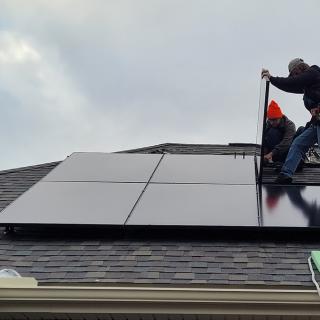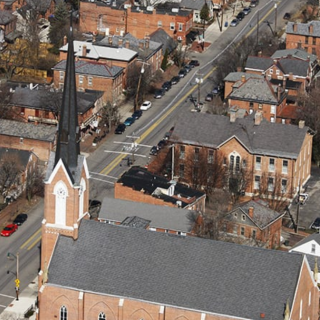Exactly why has the City of Columbus and the Ohio Department of Transportation (ODOT) removed large areas of tree canopy and brush from Columbus over the past several years? According to some homeowners and activists in Franklinton, ODOT accidentally let the cat out of the bag. Telling them during a meeting it was because “homeless live there.”
Other Franklinton homeowners refute ODOT’s slip-of-the-tongue explanation, saying there is no conspiracy against the unhoused, instead they contend ODOT lied during the meeting to conceal the truth. Which is that ODOT and its private contractors failed to follow their protocols due to incompetence and laziness.
Nevertheless, in April of 2024, ODOT with help from local contractors, removed roughly six acres of trees and brush off the slopes of SR-315 and I-70 within Franklinton. Incidentally, ODOT’s contractors also at that time cut down $30,000 worth of City of Columbus trees planted on a city easement between city and ODOT property. Rosalie Hendon, Columbus’s City Forester, has requested ODOT pay to have them replaced.
These six acres of trees and brush had remained untouched for 45 years and was a natural sound barrier to heavy freeway traffic. Those slopes are state property, but what is plainly obvious is that both the City of Columbus and ODOT have been cutting down greenery throughout the city during an era of increasing and alarming homelessness.
What makes this a headscratcher is how our city government is talking out both sides of its mouth when it comes to increasing Columbus’s tree canopy, which is vital for the entire community.
According to the Tree Equity Score, a nonprofit supported by the likes of Microsoft, most of Franklinton’s canopy cover is around 14 percent yet ideally should be 40 percent. What many residents may not be aware of is how the Columbus Urban Forestry Master Plan wants to double Columbus’s tree canopy by 2050. However, federal funding to help support the program was recently frozen by the Trump administration and City Attorney Zach Klein’s office is threatening legal action if eliminated entirely.
Trees absorb air pollution and carbon, and create oxygen, as many know. They prevent heat-related deaths, and Columbus ranks in the top 10 of the most intense summer urban heat islands. Columbus’s canopy cover is at 22 percent compared to 40 percent for both Cincinnati and Pittsburgh.
Esther Dwyer DeBusk owns a red brick Franklinton home with a large lawn, and it is the last house on the block before 315. DeBusk is an Environment Sustainability professor at Ohio State “They cut down trees by the wrong person’s house,” she says. She and another Franklinton homeowner and activist, Rebecca Hunley, wanted answers from ODOT after the slopes were scraped bare.
“We had a meeting with them, and asked them, ‘Why did you do this?’” DeBusk told the Free Press. “At first they were like, ‘We were removing invasive species.’ But they removed native species. Then they told us, ‘Oh well, there are homeless people living in there, so we have to get rid of the trees.’”
She and her neighbors knew the unhoused were living in the green space, but it wasn’t a problem. The less fortunate are part of the neighborhood and we try to care for them, she said. A Free Press reporter met with DeBusk on a recent Saturday afternoon where some of her students were helping to plant 400 “tiny” trees on her expansive lawn which is roughly one-hundred feet from 315. A neighbor paid for them, and her and her students were doing this “as a way to put back some sound barrier, esthetic, and some of the canopy.”
“So the solution to address the unhoused population is to remove six acres of trees for an entire neighborhood, that has been determined to specifically need a barrier for the health of the people that live there? Are you kidding me? That was the solution?” asked DeBusk.
Rebecca Hunley was born at Mount Carmel West, owns a home in Franklinton, and is the current chair of the Franklinton Area Neighbors Civic Association, an organization she founded. Her determination to better Franklinton for everyone is beyond evident and infectious.
“We keep planting trees, but you can’t keep a tree in Franklinton. They are under assault from everybody evidentially. The government or utilities, for example,” she said. “We can plant trees but there’s no guarantee they won’t mow them down.”
Hunley doesn’t necessarily agree that ODOT cut the slopes bare so to flush out the unhoused. Indeed, during the meeting where 25-plus Franklinton residents wanted answers – a meeting which also involved Ohio House of Rep. Dontavius L. Jarrells (D-Columbus) and several City of Columbus officials – ODOT offered a variety of answers other than the “homeless” explanation. Hunley says all the answers ODOT gave were “lies.” The local contractors hired by ODOT were simply “incompetent” and “lazy,” she says.
ODOT, in an effort to save money, contracted most of its tree and brush removal on state property to private mowing and landscaping companies several years ago. But this area of Franklinton was never contracted out, and residents began airing concerns as grass in some areas grew to six feet high. ODOT didn’t have an explanation as to why this neighborhood was left out, says Hunley. And after residents complained, ODOT finally sent their contractors to do the job.
“They just turned their contractors loose because it is easier just to clear cut for them than to the do the selective foresting,” said Hunley. After much pressure from Hunley, DeBusk and others, ODOT’s contractors began “selective cutting” – saving mature trees – earlier this year.
Hunley wonders why ODOT never bothered with these slopes and other areas for 45 years. Again, it’s a headscratcher which unsurprisingly made many Franklinton residents wonder if this was a deliberate yet undisclosed strategy to make life even more challenging for the unhoused.
DeBusk wants ODOT to keep in mind that her Franklinton neighborhood has one of the lowest median incomes in Columbus and has one of the lowest life expectancy rates in the state. As for our own city government’s role in all of this, she’s not sure what to believe.
“This neighborhood has one of the lowest canopy rates in the city,” she said. “We’ve been trying to maintain positive a connection with ODOT so that we can plant out there, so I don’t want to burn that bridge. One thing I am learning is that the city does not have any power when it comes to the state. Especially with ODOT. It seems like ODOT just has a blank check to do whatever they want, even in vulnerable neighborhoods like this. Even in the face of city goals and heavy city investment for things like trees. It’s their property technically, but it is also our property. That’s public property.”



